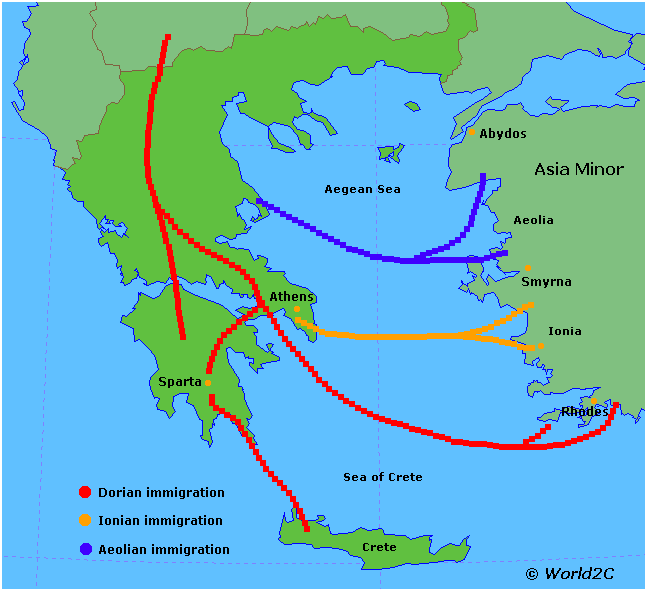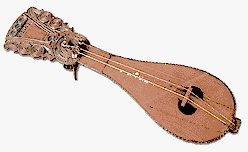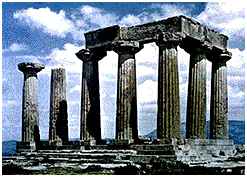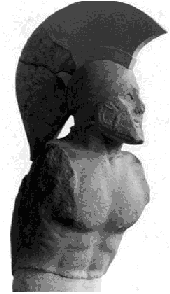Sfakian People and the Dorians
"In the southwest part of the island of Crete today lives a Dorian Greek tribe. They are very tall, fair haired and have blue eyes."

In actual fact, the origins of the Dorians, a pastoral people, are necessarily obscure, but it appears they originated in northern and northwestern Greece, i.e. Macedonia and Epirus. From there they apparently swept southward into central Greece and then into the southern Aegean area in successive migrations beginning about 1100 BC, at the end of the Bronze Age. This new people brought with it a new material, iron, which was of Balkan origin.
Dorian Greeks settled in Illyria before 2000 BC, ancient regions of the Balkan peninsula occupied by Indo-European-speaking tribes, including the Dalmatians and Pannonians. Warlike and piratical, they withstood (6th cent. B.C.) Greeks attracted by their iron mines and later attacks by Macedonians. The Romans conquered them and set up (168-167 B.C.) the province of Illyricum. Today Illyria means the Adriatic coast North of central Albania.
Illyrian culture is believed to have evolved from the Stone Age and to have manifested itself in the territory of Albania toward the beginning of the Bronze Age, about 2000 BC. The Illyrians were not a uniform body of people but a conglomeration of many tribes that inhabited the western part of the Balkans, from what is now Slovenia in the northwest to (and including) the region of Epirus, which extends about halfway down the mainland of modern Greece. In general, Illyrians in the highlands were more isolated than those in the lowlands, and their culture evolved more slowly, a distinction that persisted throughout history. In its beginning, the kingdom of Illyria comprised the actual territories of Dalmatia, Croatia, Bosnia and Herzegovina, Montenegro, with a large part of modern Serbia. Shkodra (Scutari) was its capital, just as it is now, the most important center of Northern Albania. The earliest known king of Illyria was Hyllus (The Star) who is recorded to have died in the year 1225 B.C.
The Illyrians carried on commerce and warfare with their neighbors. The ancient Macedonians probably had some Illyrian roots, but their ruling class adopted Greek cultural characteristics. The Illyrians also mingled with the Thracians, another ancient people with adjoining lands on the east. In the south and along the Adriatic Sea coast, the Illyrians were heavily influenced by the Greeks, who founded trading colonies there. The present-day city of Durrës evolved from a Greek colony known as Epidamnos, which was founded at the end of the seventh century B.C. Another famous Greek colony, Apollonia, arose between Durrës and the port city of Vlorë. The Illyrians produced and traded cattle, horses, agricultural goods and wares fashioned from locally mined copper and iron. Feuds and warfare were constant facts of life for the Illyrian tribes, and Illyrian pirates plagued shipping on the Adriatic Sea.
The first hellenic tribes of Dorians and Achaeoi resided in Macedonia in prehistoric times, first in Emathia near mountain Vermion and later expanded northwards and eastwards.

The warrior-like Dorians fanned out over much of the mainland, razing the city-states and enslaving the inhabitants, and later conquered Crete and the southwest coast of Asia Minor. Other Indo-European tribes known as the Thessalians settled in what is now Thessaly. Of the original Greek tribal groups, the Aeolians fled to the northwest coast of Asia Minor; the Ionians sought refuge on the central coast and the islands of Lesbos, Samos and Chios, although they also held out in mainland Greece, in Attica and the well-fortified city of Athens.
According to Herodotos, the Makednoi (Macedonians) who crossed Doris and moved to the Peloponnese were later called Dorians. The Dorians who formed the Macedonian state came in contact with the local Pelasgic population whose size was much smaller than the one residing at the sea shores and the islands of Southern Greece. It is for this reason that German historian K. Belloch considered the Macedonians the purest Greeks of any other part of Greece. The Dorians (Makednoi) of Macedonia were larger in number than those who moved southwards. This is because those who moved southwards were reduced in number either due to attrition or to settlements in the areas they visited along their movement to Southern Greece. Such a place of permanent residence for some Makednoi (Dorians) was Doris. When these Dorians (known until then as Makednoi only) moved to the Peloponnese, they became known there as Dorians (that is, the people [coming] from Doris).
They arrived in the Peloponesse between 1100 and 950 B.C., drove out the Achaeans, the ruling class from 1250 BC, and rapidly extended their influence. Sparta, Corinth and parts of Crete were Dorian centers. The Dorians' arrival inaugurated a period of Greek decline, but they did contribute to Greek culture as well, particularly in the Doric style of architecture. Iron marked the end of the Mycenaean Age and the transition to the "Geometric Period" in the field of art.

Sparta, located on the south end of the Peloponnese, was known for its great military power in the Hellenic world. They were of Dorian decent which captured most of Greece with its iron spears that were harder and more destructive than bronze. From early childhood, boys were trained for war, taught to fight and to be tough. Many times they were kept from eating, sleeping, and were never allowed to cry. This would teach them how to be "streetwise" and have cunning. They were brave men of few words.
It was law in Sparta that their kingdom be ruled by 2 kings, one from each of two equally rich royal houses. This was known as aristocratic power.
The Dorians settled chiefly in the southern and eastern Peloponnese, establishing strong centres in Laconia (and its capital, Sparta), Messenia, Argolís, and the region of the Isthmus of Corinth. They also settled the southern Aegean islands of Melos, Thera, Rhodes, and Cos, along with the island of Crete. In fact, the Dorians reached as far east as the cities of Halicarnassus and Cnidus on the coast of mainland Anatolia (now southwestern Turkey). A great wave of renewed colonization beginning in the 8th century BC brought Dorian settlers to the island of Corcyra (modern Corfu), to Syracuse, Gela, and Acragas (now Agrigento) in Sicily, to Taras (now Taranto) in Italy, and to Cyrene in North Africa, as well as to scattered sites in the Crimea and along the Black Sea. Sparta, Corinth, and Argos were among the most important cities of Doric origin.
Doris is the name of two regions : one in continental Greece, between Phocis south and Thessalia north, Locris east and Aetolia west, a region previously called Dryopis; another one in southwestern Asia Minor, along the coast of Caria down to the island of Rhodes. Both regions owe their name to the fact that they were settled by Dorians. Mythology talks of a Dorus who was the eponym of the Dorians. He was a son of Hellen and thus a grandson of Deucalion and Pyrrha and a brother of Æolus (though there is another tradition, in which Dorus was presented as the son of Apollo and Phthia).
Dorus originally lived in Phthiotis, but his offspring moved north toward the region of Mount Olympus, then inward toward the Pindus range between Thessalia and Epirus under pressure from the Cadmeans (the Phoenicians, offspring of Cadmus settled in the area of Thebes), before moving back south, first in the area now called Doris south of Phthiotis, then at last in Peloponnese, where the Dorian, presented as a people often on the move, are opposed to the Ionians, seen as descendants of the native Pelasges.
The decline of Mycenaean power followed soon after the fall of Troy. Thucydides explained that "the late return of the Hellenes from Ilium caused many revolutions," leading to exiled citizens founding cities. A defensive wall built across the isthmus of Corinth implies they feared an attack from the north. According to tradition the Dorians, who came from the northwest led by those who claimed descent from Heracles (that's one of the reasons why nowadays capital of Crete is named Heraklion, the main reason is Heracles fought with the Minotaur), returned a century after their first attempt by crossing the Gulf of Corinth. Thucydides wrote that the Dorians mastered the Peloponnese eighty years after the fall of the Troy.
After the Dorian invasion of Crete, the face of Crete remained without expression for centuries. From 1200 BC the island of Minos, the victim of a political as well as a geographical or economic isolation, withdrew into its past. When Crete was discovered by historians and philosophers of the 4th century BC, what they praised or condemned in its institutions and customs was the old Doric inheritance.
In the southwest part of the island of Crete today still lives a Dorian Greek tribe, in the region of Sfakia, remnants of Dorian invasion from 3000 years ago, which have changed little over the period of 3000 years due to their isolation because of the very unaccessible terrain. They are very tall, lighter haired and lighter eyed than surrounding Greeks in that region, but have overall Greek features.
In the book ' Races of Europe ', written by Coon in 1939 they are clearly compared with todays Montenigrins in height, appearance, national costume and possesion of the instrument lyra (after which Illyria was named).

As the Dorians settled many areas of the Aegean, their way of rulership, was generally to merge with the indigenous people of their land, as seen with the invasion of Corinth, Rhodes and Argos. In other instances however, such as in the case of Sparta and Crete, the Dorians kept power entirely to themselves, creating a ruling military class which they solely occupied. Such a political state, purposefully "froze" the old archaic cultures of Ancient Greece to maintain dominion over a population decimated to serfdom. Regardless, Sparta was to remain the main city of the Dorians which lasted well into the age of classical Greece. Doric language was a dialect spoken in Ancient Greece, overshadowed during the Classical Age by other dialects such as Ionic-Attic, Aeolic, and Arcado Cypriot, the latter dominating Greek language from the 5th century BC onward. Dorian artistic elements proved to be integral to the artistic traditions of ancient Greece. Among the many artistic elements used by the Greeks, was the Doric architectural element of large order and structure, which first originated within the populated cities of the southern Aegean. Other artistic contributions of the Dorians included the use of choral lyrics in Greek Tragedy.

Sparta was not
a colonizing state, though the inhabitants of Tarentum, in southern
Italy, and of Lyttus, in western Crete, the most ancient
city in Crete, claimed her as their mothercity. The Minoan civilization
was destroyed in about 1400 B.C. with the eruption of the Santorini
volcano at the island of Thera, about 70 miles north of Crete. It
is thought that first a huge tidal wave struck the island, destroying
coastal cities and populations, and that then volcanic ash came
down, burying the whole island. Arthur Evans uncovered the buildings
3300 years later.
Of course, the island began to be repopulated immediately as people
migrated from the mainland. In about 600 B.C., the Dorian Greeks
came in force and settled the island by conquest, with the help
of their iron weapons. Their cousins were the Spartan Greeks from
the Peloponnese and the Philistine Greeks of Palestine.
The local population was reduced to serfdom and Crete was divided into townships. Spartan Greeks settled on the island in cities like Lyttus. All of the Greeks on the island were warlike, fierce fighters who prided themselves on their independence and warrior qualities. Island people have a tendency to be independent, and this trait was augmented by their heredity. The townships were intensely jeaulous of one another, leading to 10 centuries of internal strife.
"The city of Lyttus met with an irremediable disaster. Knossians and Gortynians had subjected the whole island, except for Lyttus (about 225 B.C.). Since Lyttus would not surrender to them, they declared war against it. At first, all the Cretans took part in the war against the Lyttans; but jealousy sprang up from some trifling cause, as is common with the Cretans. Several cities went over to the aid of Lyttus. "Meanwhile, the city of Gortyn was having civil war, in which the elder citizens were taking the side of Knossos and the younger were siding with Lyttus. The elder Gortynians, with the help of Knossians and Aetolians, whom they had secretly let into the city and the citadel, put to death the younger citizens, delivering the city of Gortyn to Knossos. "At about the same time, the Lyttians left with their whole force for an expedition into enemy territory. But the Knossians got word of their departure and used the opportunity to occupy Lyttus, destroying the town and sending the populace into slavery. The Lyttus military returned to a gutted city and were so distraught that they didn't even enter the town, but sought refuge in the city of Lappa, becoming in one day cityless aliens instead of citizens. "Thus, Lyttus, a colony of the Spartans, and allied to them by blood, the most ancient city in Crete, and the breeding place of her bravest men, was utterly and unexpectedly made away with."
[from Polybius, one of the most famous and prolific Greek historians of Roman times, Volume II, 429ff]
(Note: Nowadays little remains of the important Dorian-Greek city of Lyttus/ Lyttos/ Lyktos. It used to have its own coins and had its own port down at Hersonissos. The remains can be found east of Kasteli (southeast of Heraklion), near the village of Xidas; thanks to John Bowman's Travellers' guide to Crete, 1962-1990)
Some elements of the Dorian social structure and customs from Sparta still have their influence on everyday life in Sfakia. Although this is highly hypothetical and sources are either hostile or idealising, the following Spartan social elements seem to have their remainder in the Sfakian society:
- • Sparta's historical situation : an armed camp, Military state, Education primarily for military ends, Society organized around the army, family devalued
- • Classes of Spartan: citizen (=aristocrat), perioikoi (= free non-citizen), helot (= Messenian serf)
- • Spartan male life-cycle: boys left for the mess at age 7, married around age 20, did not live with their wives until age 30, frequently away after that (on campaign etc)
- • The family was devalued for the males: women's social position still rooted in the family structure, all ancient texts agree that women were more powerful in Sparta than elsewhere in Greece
- • Female-dominated households: women married around age 18, they had primary control of the household? from then on or their mothers-in-law did household, in any event apparently female-dominated, women formed the major parent-child bond with their children, Spartan mothers' influence on their sons (anecdotal evidence)
- • Inheritance: Women could inherit, (some) control of the disposition of the inheritance, no dowries, but inheritances, gifts, and bequests, some Spartan women very rich
- • Marriage decided by fathers
- • Education: well-educated, Plato says, in literature and the arts, strong physical education, their main task was to raise warriors

The author wishes to state that this article is just an anthology of history and not a political statement. It's meant to describe some general developments over time and this does not imply to favor any political view, ethnic group or nationality. 'Facts' are mentioned 'as is' just for further reading and do not necessarily reflect the authors private opinion.








